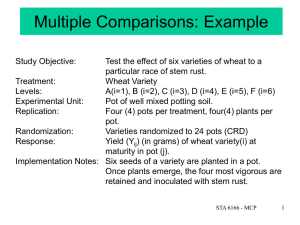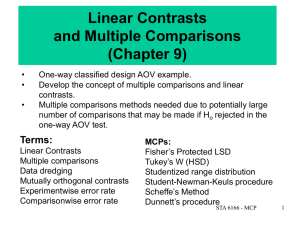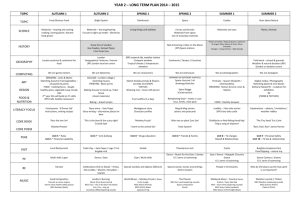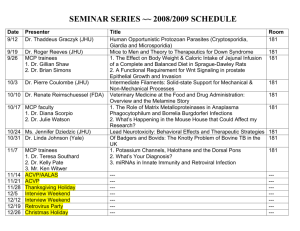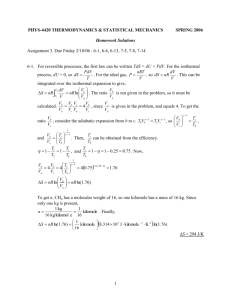U3.4-MultipleComparisons
advertisement
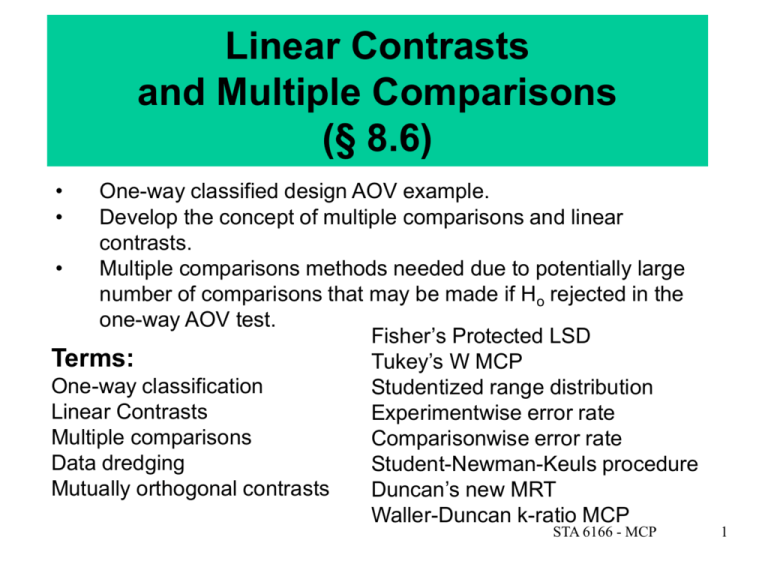
Linear Contrasts
and Multiple Comparisons
(§ 8.6)
•
•
One-way classified design AOV example.
Develop the concept of multiple comparisons and linear
contrasts.
•
Multiple comparisons methods needed due to potentially large
number of comparisons that may be made if Ho rejected in the
one-way AOV test.
Fisher’s Protected LSD
Terms:
Tukey’s W MCP
One-way classification
Studentized range distribution
Linear Contrasts
Experimentwise error rate
Multiple comparisons
Comparisonwise error rate
Data dredging
Student-Newman-Keuls procedure
Mutually orthogonal contrasts
Duncan’s new MRT
Waller-Duncan k-ratio MCP
STA 6166 - MCP
1
One-Way Layout Example
A study was performed to examine the effect of a new sleep inducing drug on a
population of insomniacs. Three (3) treatments were used:
Standard Drug
New Drug
Placebo (as a control)
What is the role of the placebo in this study?
What is a control in an experimental study?
18 individuals were drawn (at random) from a list of known insomniacs
maintained by local physicians. Each individual was randomly assigned to
one of three groups. Each group was assigned a treatment. Neither the
patient nor the physician knew, until the end of the study, which treatment they
were on (double-blinded).
Why double-blind?
A proper experiment should be:
randomized, controlled, and double-blinded.
STA 6166 - MCP
2
Response:
Average number of hours of sleep per night.
Placebo:
Standard Drug:
New Drug:
6.5, 5.7, 5.1, 3.8, 4.6, 5.1
8.4, 8.2, 8.8, 7.1, 7.2, 8.0
10.6, 6.6, 8.0, 8.0, 6.8, 6.6
yij = response for the j-th individual on the i-th treatment.
Standard
Placebo
Drug
New Drug
5.60
8.40
10.60
5.70
8.20
6.60
5.10
8.80
8.00
3.80
7.10
8.00
4.60
7.20
6.80
5.10
8.00
6.60
sum
29.900
47.700
46.600
mean
4.983
7.950
7.767
variance
0.494
0.455
2.359
pooled variance
1.102
SSW
16.537
variance of the means
2.764
Between mean SSQ (SSB)
16.582
Degrees
Sums of
of
Source
Squares Freedom
Between Groups
33.16
2
Within Groups
16.54
15
Total
49.70
17
TSS
(y
ij
y ) 2
i, j
Hartley’s test for equal variances:
Fmax = 4.77
< Fmax_critical = 10.8
Mean
Square F statistic
16.582
15.04
1.102
P-value
0.00026
SSW
SSB
( yij yi ) 2
ni ( yi y ) 2
i, j
i
SSB
t 1
SSW
2
MSW sw
nT t
MSB
F
~ Fdfb ,dfw
MSW
2
MSB sb
STA 6166 - MCP
3
Excell Analysis Tool Output
Anova: Single Factor
SUMMARY
Groups
Placebo
Standard Drug
New Drug
ANOVA
Source of Variation
Between Groups
Within Groups
Total
Count
6
6
6
SS
33.163333
16.536667
49.7
Sum
Average Variance
29.9 4.983333 0.493667
47.7
7.95
0.455
46.6 7.766667 2.358667
df
MS
F
2 16.58167 15.04082
15 1.102444
P-value
F crit
0.00026 3.682317
17
What do we conclude here?
STA 6166 - MCP
4
Linear Contrasts and Multiple Comparisons
If we reject H0 of no differences in treatment means in favor of
HA, we conclude that at least one of the t population means
differs from the other t-1.
Which means differ from each other?
Multiple comparison procedures have been developed to help
determine which means are significantly different from each other.
Many different approaches - not all produce the same result.
Data dredging and data snooping - analyzing only those
comparisons which look interesting after looking at the data
– affects the error rate!
Problems with the confidence assumed for the comparisons:
1-a for a particular pre-specified comparison?
1-a for all unplanned comparisons as a group?
STA 6166 - MCP
5
Linear Comparisons
Any linear comparison among t population means, m1, m2, ...., mt can
be written as:
l a1m1 a2m2 at mt
t
ai 0
Where the ai are constants satisfying the constraint:
i 1
Example: To compare m1 to m2 we use the equation:
l m1 m2
with
coefficients
a1 1
a2 1
a3 a4 at 0
Note
constraint
is met!
m2 m3
l m1
(1)m1 ( 21 )m 2 ( 21 )m 3
2
STA 6166 - MCP
6
Linear Contrast
l m 1 m 2 y1 y 2
A linear comparison
estimated by using group
means is called a linear
contrast.
l m m 2 m 3 (1)y ( 1 )y ( 1 )y
1
1
2 2
2 3
2
Variance of a linear contrast:
V (l)
2 a1
sw n
1
2
2
a2
n2
at
n
t
t
ai yi
Test of
i 1
MSl
significance
t ai2
i 1 ni
H : l = 0 vs. H : l 0
o
2
2
2
sw
t
i 1
2
ai
ni
sw2 MSE
( MSW )
MSl
F
~ F1,nT t
MSE
a
STA 6166 - MCP
7
Orthogonal Contrasts
lˆ1 a1 y1 a2 y2 at yt
lˆ b y b y b y
2
1 1
2
2
t
t
These two contrasts are said to be orthogonal if:
t
l1 l2 a1b1 a2b2 at bt ai bi 0
i 1
in which case l1 conveys no information about l2 and viceversa.
A set of three or more contrasts are said to
be mutually orthogonal if all pairs of linear
contrasts are orthogonal.
STA 6166 - MCP
8
ˆl y y2 y3
1
1
2
lˆ y y
2
2
a1 1
1
a2
2
1
a3
2
Compare average of drugs (2,3) to placebo (1).
Contrast drugs (2,3).
3
b1 0
Orthogonal
b2 1
b3 1
Non-orthogonal
Contrast Standard drug (2) to placebo (1).
Contrast New drug (3) to placebo (1).
lˆ3 y1 y2
lˆ4 y1 y3
a1 1
b1 1
a2 1
b2 0
a3 0
b3 1
STA 6166 - MCP
9
Drug Comparisons
Standard
Placebo
Drug
New Drug
5.60
8.40
10.60
5.70
8.20
6.60
5.10
8.80
8.00
3.80
7.10
8.00
4.60
7.20
6.80
5.10
8.00
6.60
sum
29.900
47.700
46.600
mean
4.983
7.950
7.767
variance
0.494
0.455
2.359
pooled variance
1.102
SSW
16.537
variance of the means
2.764
Between mean SSQ (SSB)
16.582
F
MSl1
~ F1, nT t
MSE
MSlˆ1 33.10
F1
30.04
MSE 1.102
MSlˆ2 0.10
F2
0.09
MSE 1.102
F1,15,.05 4.54
Degrees
Sums of
of
Source
Squares Freedom
Between Groups
33.16
2
Within Groups
16.54
15
Total
49.70
17
Mean
Square F statistic
16.582
15.04
1.102
P-value
0.00026
y y
7.95 7.77
lˆ1 y1 2 3 4.98
2.88
2
2
lˆ y y 7.95 7.77 0.18
2
2
3
2
(1) 2 (.5) 2 (.5) 2
a22 a32
2 a1
ˆ
1.102(0.25)
V l1 sW 1.102
n
n
n
6
6
6
2
3
1
2
(0) 2 (1) 2 (1) 2
b22 b32
2 b1
ˆ
1.102(0.33)
V l2 sW 1.102
n
n
n
6
6
6
2
3
1
2
2
lˆ1
2.88
33.10
ai2
0.25
ni
i
2
2
lˆ2
0.18
ˆ
ˆ
SSl2 MSl2
0.10
bi2
0.33
STA 6166 - MCP
i n
i
SSlˆ1 MSlˆ1
10
Importance of Mutual Orthogonality
Assume t treatment groups, each group having n individuals (units).
•
•
t-1 mutually orthogonal contrasts can be formed from the t
means. (Remember t-1 degrees of freedom.)
Treatment sums of squares (SSB) can be computed as the sum
of the sums of squares associated with the t-1 orthogonal
contrasts. (i.e. the treatment sums of squares can be partitioned
into t-1 parts associated with t-1 mutually orthogonal contrasts).
contrasts orthogonal SSl1 SSlt 1 SSB
t-1 independent pieces of information about the
variability in the treatment means.
STA 6166 - MCP
11
Example of Linear Contrasts
Objective:
Treatments:
Treatment
A
B
C
D
Test the wear quality of a new paint.
Weather and wood combinations.
Code
m1
m2
m3
m4
Combination
hardwood, dry climate
hardwood, wet climate
softwood, dry climate
softwood, wet climate
(Obvious) Questions:
Q1: Is the average life on hardwood the same as average life
on softwood?
Q2: Is the average life in dry climate the same as average life
in wet climate?
Q3: Does the difference in paint life between wet and dry
climates depend upon whether the wood is hard
soft?
STAor
6166
- MCP
12
Treatment
Mean
(in years)
ni
Population
parameter
A
B
C
D
13
3
14
3
20
3
21
3
m1
m2
m3
m4
Q1
MSE=
t=
nt -t=
5
4
8
Q1: Is the average life on hardwood the same as average life on softwood?
1
0
H :
m1 m 2 m3 m 4
2
2
Comparison:
OR
m1 m 2 m3 m 4
2 2 0
l1 ( 12 )m1 ( 12 )m2 ( 12 )m3 ( 12 )m 4
l̂1 ( 12 )y1 ( 12 )y 2 ( 12 )y3 ( 12 )y 4
Estimated Contrast
Test H0: l1 = 0 versus HA: l1 0
Test Statistic: F
What is MSl1 ?
MSl1
MSE
Rejection Region: Reject H0 if
F F1,nT t,a
STA 6166 - MCP
13
2
t
2
a
y
1
1
1
1
i i
y
y
y
y
1
2
3
4
2
2
2
2
MSl1 i1t 2
ai
1 2 1 2 1 2 1 2
2
2
2
2
n
i
1
i
n2
n3
n4
n1
2
t
2
1
1
1
1
ai yi
13
14
20
21
2 2 2
2 49
MSl1 i1t 2
147
2
2
2
2
1
ai
1
1
12
12
2
2
3
n
i1 i
3
3
3
3
MSl1 147
=
= 29.4
MSE
5
F1,8,0.05 = 5.32
F=
Conclusion: Since F=29.4 > 5.32 we reject H0 and conclude that
there is a significant difference in average life on hard versus
soft woods.
STA 6166 - MCP
14
Treatment
Mean
(in years)
ni
Population
parameter
A
B
C
D
13
3
14
3
20
3
21
3
m1
m2
m3
m4
Q2
MSE=
t=
nt -t=
5
4
8
Q2: Is the average life in dry climate the same as average life in wet climate?
H 02 :
m1 m 3
2
m2 m4
2
OR
m1 m 3 m 2 m 4
0
2 2
Comparison: l2 ( 12 )m1 ( 12 )m 2 ( 12 )m3 ( 12 )m 4
l̂2 ( 12 )y1 ( 12 )y 2 ( 12 )y3 ( 12 )y 4
Estimated Contrast
Test H0: l2 = 0 versus HA: l2 0
Test Statistic: F =
MSl2
MSE
Rejection Region: Reject H0 if
F > F1,nT - t,a
STA 6166 - MCP
15
2
t
2
a
y
1
1
1
1
i i
y
y
y
y
1
2
3
4
2
2
2
2
MSl2 i1t 2
ai
1 2 1 2 1 2 1 2
2
2
2
2
n
i
1
i
n2
n3
n4
n1
2
t
2
1
1
1
1
ai yi
13
14
20
21
2 2 2
2 12
i1
MSl2
3
2
2
2
2
2
t
1
ai
1
1
12
12
2
2
3
n
i1 i
3
3
3
3
MSl2 3
= = 0.6
MSE 5
F1,8,0.05 = 5.32
F=
Conclusion: Since F=0.6 < 5.32 we do not reject H0 and
conclude that there is not a significant difference in average life
in wet versus dry climates.
STA 6166 - MCP
16
Treatment
Mean
(in years)
ni
Population
parameter
A
B
C
D
13
3
14
3
20
3
21
3
m1
m2
m3
m4
Q3
MSE=
t=
nt -t=
5
4
8
Q3: Does the difference in paint life between wet and dry climates depend
upon whether the wood is hard or soft?
H30 :
m1 m 2 m3 m 4
OR
(m1 m 2 ) (m3 m 4 ) 0
Comparison: l3 (1)m1 ( 1)m2 ( 1)m3 (1)m 4
l̂3 (1)y1 (1)y 2 ( 1)y3 (1)y 4
Estimated Contrast
Test H0: l3 = 0 versus HA: l3 0
Test Statistic: F
MSl3
MSE
Rejection Region: Reject H0 if
F F1,nT t,a
STA 6166 - MCP
17
2
t
2
a
y
i i
1
y
1
y
1
y
1
y
1
2
3
4
MSl3 i1t 2
ai
12 12 12 12
n
i
1
i
n2
n3
n4
n1
2
t
2
ai yi
1
13
1
14
1
20
1
21
02
i1
MSl3
0
2
2
2
2
2
t
ai
1
4
1
1
1
3
n
i1 i
3
3
3
3
MSl3 0
= = 0
MSE 5
F1,8,0.05 = 5.32
F=
Conclusion: Since F=0 < 5.32 we do not reject H0 and conclude
that the difference between average paint life between wet and
dry climates does not depend on wood type. Likewise, the
difference between average paint life for the wood types does
STA 6166 - MCP
not depend on climate type (i.e. there is no interaction).
18
Mutual Orthogonality
Contrast
a1
a2
a3
a4
l1
1
2
1
2
12
12
l2
1
2
1
2
1
2
12
l3
1
1
1
1
l1 l2 14 14 14 14 0
l1 l3 12 12 12 12 0
l2 l3 12 12 12 12 0
The three are mutually orthogonal.
SSl1 = MSl1
SSl2 = MSl2
SSl3 = MSl3
Treatment SS
=
=
=
=
147
3
0
150
The three mutually orthogonal contrasts
add up to the Treatment Sums of
Squares.
Total Error SS = dferror x MSE = 8 x 5 = 40
STA 6166 - MCP
19
Types of Error Rates
Compairsonwise Error Rate - the
probability of making a Type I error in
the comparison of two means. (what
we have been discussing for all tests
up to this point).
Experimentwise Error Rate - the
probability of observing an
experiment in which one or more of
the pairwise comparisons are
incorrectly declared significantly
different. (Type I error.)
Number of
Type I
Experimentwise
comparsons Error Rate
Error Rate
1
0.05
0.050
2
0.05
0.098
3
0.05
0.143
4
0.05
0.185
5
0.05
0.226
6
0.05
0.265
7
0.05
0.302
8
0.05
0.337
9
0.05
0.370
10
0.05
0.401
11
0.05
0.431
12
0.05
0.460
13
0.05
0.487
14
0.05
0.512
15
0.05
0.537
16
0.05
0.560
17
0.05
0.582
18
0.05
0.603
19
0.05
0.623
20
0.05
0.642
STA 6166 - MCP
20
Error Rates: Problems
Suppose we make c mutually orthogonal
(independent) comparisons, each with Type I
comparisonwise error rate of a. The
experimentwise error rate, e, is then:
c
e 1 (1 a )
(If the comparisons are not orthogonal, then the
experimentwise error rate is smaller.)
Number of
Type I
Experimentwise
comparsons Error Rate
Error Rate
1
0.05
0.050
2
0.05
0.098
3
0.05
0.143
4
0.05
0.185
5
0.05
0.226
6
0.05
0.265
7
0.05
0.302
8
0.05
0.337
9
0.05
0.370
10
0.05
0.401
11
0.05
0.431
12
0.05
0.460
13
0.05
0.487
14
0.05
0.512
15
0.05
0.537
16
0.05
0.560
17
0.05
0.582
18
0.05
0.603
19
0.05
0.623
20
0.05
0.642
Solution (Bonferroni): set e=0.05 and solve for a.
But there’s a problem…
E.g. if c=8, we get a=0.0064!
STA 6166 - MCP
21
Multiple Comparison Procedures
Terms:
• If the multiple comparison procedure (MCP) requires a significant
overall F test, then the procedure is labeled a “Protected” method.
• Not all procedures produce the same results.
• The major differences among all of the different MCPs is in the
calculation of the “yardstick” used to determine if two means are
significantly different. The yardstick can generically be referred to as
the least significant difference. Any two means greater than this
difference are declared significantly different.
y i y j " yardstick" " TabledValue"" SEof difference"
• Yardsticks are composed of a standard error term and a critical
value from some tabulated statistic.
• Some procedures have “fixed” yardsticks, some have “variable”
yardsticks. The variable yardsticks will depend on how far apart
two observed means are in a rank ordered list of the mean values.
• Some procedures control Comparisonwise Error, other
Experimentwise Error, and some attempt to control both.
STA 6166 - MCP
22
Fisher’s Least Significant Difference - Protected
Mean of group i (mi) is significantly different from the mean of group
j (mj) if
if all groups have
same size n.
y i y j LSD
LSD t a 2 ,dferror
2 1 1
sw ni n j t a 2 ,dferror MSE
2
n
{tabled value}{standard error of difference}
Type I (comparisonwise) error rate = a
This procedure controls Comparisonwise Error. Experimentwise
error control comes from requiring a significant overall F test prior to
performing any means comparisons.
How well does it work?
STA 6166 - MCP
23
Tukey’s W (Honestly Significant
Difference) Procedure
Means are different if:
yi y j W
W = qa (t , nT - t ) sw2 (1n ) = qa (t , nT - t )
MSE
n
{Table 11 - critical values of the studentized range.}
Experimentwise error rate = a
This MCP controls experimentwise error
rate! Comparisonwise error rates is
thus very low.
How well does it work?
STA 6166 - MCP
24
Student Newman Keul Procedure
Rank the t sample means from smallest to largest. For two
means that are r “steps” apart in the ranked list, we declare the
population means different if (modified Tukey’s MCP):
y i y j Wr
Wr qa (r , nT t )
qa (r, nT t )
2 1
sw n
MSE
n
{Table 11 - critical values of the studentized range. Depends on
which mean pair is being considered!}
y [1] min
r=2
y [ 3]
y [2]
r=3
y [5]
y [4]
r=4
r=5
y [ 6] max
r=6
varying
yardstick
STA 6166 - MCP
25
Duncan’s New Multiple Range Test
Neither an experimentwise or comparisonwise error rate control alone.
Based on a ranking of the observed means.
Introduces the concept of a “protection level” (1-a)r-1
Number of steps
Apart, r
2
3
4
5
6
7
y i y j Wr
Protection Level
(0.95)r-1
.950
.903
.857
.815
.774
.735
Probability of
Falsely Rejecting H0
.050
.097
.143
.185
.226
.265
Wr q a (r , nT t )
MSE
n
{Table A -11 in these notes}
STA 6166 - MCP
26
Waller-Duncan k-ratio MCP (Protected)
A MCP that uses the sample data to help in determining
whether we need to use a conservative rule (e.g. Tukey’s MCP)
or a nonconservative rule (e.g. Fisher’s MCP).
y i y j LSD
LSD t c MSE
n2
tc is obtained from Table A-12 or A-13 (in these notes) and is based
on:
•
k - the error weight ratio which designates the seriousness of a
Type I error to a Type II error. (typical values 50, 100, 500.
•
df1 - the model degrees of freedom. (i.e. t-1).
•
df2 - the error degrees of freedom (i.e. t(n-1)).
•
F - the F statistics from the overall model effects test.
•
the assumption of equal group sample sizes.
STA 6166 - MCP
27
Scheffé’s S Method
For any linear contrast:
Estimated by:
With estimated variance:
l a1m1 a2m2 at mt
l̂ a1y1 a2 y 2 at y t
V̂( l̂ ) s
a12
2
w n1
a 22
n2
To test H0: l = 0 versus Ha: l 0
For a specified value of a, reject H0 if:
where:
Confidence interval:
a 2t
nt
s
t
2
w
i1
ai2
ni
lˆ S
S V̂( l̂ ) ( t 1)F( t 1),(nT t ),a
l̂ S l l̂ S
STA 6166 - MCP
28
Geometric Mean
If the sample sizes are not equal in all groups, the value of
n in the previous equations is replaced with the geometric
mean of the sample sizes:
1 t
nG exp ln( ni )
t i 1
E.g. Tukey’s procedure becomes:
W = qa (t , nT - t ) s
2
w
(
1
nG
) = qa (t , nT - t )
STA 6166 - MCP
MSE
nG
29
Comparisonwise error
rates for different MCP
STA 6166 - MCP
30
Experimentwise error rates
for different MCP
STA 6166 - MCP
31
